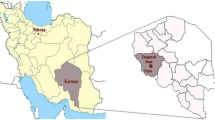Abstract
The Bakhtiary Hydropower Project with a 325 m high dam will be constructed on Bakhtiary River, in southwest Iran. The main dam has been designed as a double-curvature concrete structure which will be the highest one of its type in the world. Geologically, the dam site is located on siliceous limestone of the Sarvak Formation in the northwestern part of the folded Zagros. A large number of complicated geological structures in the study area, such as folding and duplex structure, faults, chevron folds, kink band zones as well as joint and fracture systems, raised concerns regarding the acceptability of the site for such a monumental dam. To create a comprehensive geotechnical model of the dam site and appurtenant structures, very extensive surface and subsurface investigations were carried out, including core drilling, water pressure testing, driving exploratory galleries for engineering geological mapping, a rock mass discontinuity survey and in situ rock mechanical tests. This research applies the results of the engineering geological and geotechnical investigations to define the geomechanical model of the dam site enabling options to be considered to achieve a safe dam design. The investigations show the rock mass of the dam site area is intersected by four main discontinuities namely, the bedding plane(s) of the rock mass and three major joint sets. Water pressure tests provide data about the permeability of the rock mass which is significantly dependant on the joint properties and the geological structures. These parameters, set the criteria for the design of the grout curtain at the dam foundation. The rock mass classification of the dam site was determined mainly based on the gallery survey and core logging using the rock mass rating, geological strength index (GSI) and Q system. Six classes of rock mass qualities were distinguished which show a fair to good rock mass at the dam foundation. From the plate load test results, a site-specific correlation was developed for estimating the modulus of deformation of the rock masses using GSI value. The estimated engineering geological and geotechnical parameters at the dam site are generally favorable and suitable for the safe design of the Bakhtiary arch dam with a height of 325 m.













Similar content being viewed by others
References
Barton N (1995) The influence of joint properties in modeling jointed rock masses; Keynote lecture. In: Fuji T (ed) Proceeding of the 8th ISRM Congress, Tokyo. Balkema, Rotterdam, 3: pp 1023–1032
Barton N (2002) Some new Q-value correlations to assist in site characterization and tunnel design. Int J Rock Mech Min Sci 39:185–216
Bieniawski ZT (1989) Engineering rock mass classifications. Wiley, New York
BJVC (2009a) Bakhtiary Dam and HEPP, Engineering geology and rock mechanics report; Report No. 4673/4049 Rev. 1
BJVC (2009b) Bakhtiary Dam and HEPP, Updated feasibility report of dam and appurtenant structures for upstream alternative (U2), Report No. 4673/4159 Rev. 0
Deere DU (1963) Technical description of rock cores for engineering purposes. Rock Mech Engng Geol 1:16–22
Hendron AJ, Patton FD (1987) The Vaiont slide. A geotechnical analysis based on new geologic observations of the failure surface. Eng Geol 24:475–491
Hoek E (2007) Rock Engineering, Course Notes
Hoek E, Diederichs MS (2006) Empirical estimation of rock mass modulus. Int J Rock Mech Min Sci 43:203–215
Houlsby AC (1990) Construction and design of the cement grouting: a guide to grouting in rock foundations. Wiley, New york
ISRM (1978) Suggested methods for determining in situ deformability of rock, part 1. Suggested method for deformability determination using a plate test (superficial loading). Int J Rock Mech Min Sci Geomech Abstr 16(3):197–202
ISRM (1981) Suggested methods for the quantitative description of discontinuities in rock masses. Rock Characterization, Testing and Monitoring, London. Pergamon, Oxford, p 221
Londe P (1987) The Malpasset dam failure. Eng Geol 24:295–329
Luo Y, Chen L, Xu M, Tong X (2012) Review of dam-break research of earth-rock dam combining with dam safety management. Procedia Eng 28:382–388
Mantovani F, Vita-Finzi C (2003) Neotectonics of the Vajont dam site. Geomorphology 54:33–37
Marinos P, Hoek E (2000) GSI: a geologically friendly tool for rock mass strength estimation. In: Proceeding of the International Conference on Geotechnical & Geological Engineering, GeoEng 2000, Technomic Publ., pp 1422–1442
Motiei H (1993) Geology of Iran, stratigraphy of Zagros. Geological Survey of Iran—Tehran, Iran In Persian
Paronuzzi P, Bolla A (2012) The prehistoric Vajont rockslide: an updated geological model. Geomorphology 169–170:165–191
Reddy DV (1995) Engineering geology for civil engineers. Oxf & IBH Pub. Co, New Delhi
Rogers JD (2006) Lessons learned from the St Francis dam failure. Geo-Strata 6(2):14–17
Sander B (1948) Einführung in die Gefügekunde der geologischen Körper. (Introduction to the structural petrology of geological bodies), vol. I. Wien, J. Springer, Berlin
Seed HB, Duncan JM (1987) The failure of Teton dam. Eng Geol 24:173–205
Sen Z (1990) Cumulative core index for rock quality evaluations. Int J Rock Mech Min Sci Geomech Abstr 27(2):87–94
Serafim JL (1987) Malpasset dam discussion—remembrances of failures of dams. Eng Geol 24:355–366
Unal E (1997) Determination of in situ deformation modulus: new approaches for plate-loading tests. Int J Rock Mech Min Sci 34(6):897–915
Acknowledgments
The authors desire to express their grateful thanks to site geotechnical engineers of Bakhtiary Joint Venture Consultants (BJVC), for providing the test results. Special thanks to the project director, Iran Water and Power Resources Development Co. (IWPC), for their kindly permission to publish this paper.
Author information
Authors and Affiliations
Corresponding author
Rights and permissions
About this article
Cite this article
Haftani, M., Gheshmipour, A.A., Mehinrad, A. et al. Geotechnical characteristics of Bakhtiary dam site, SW Iran: the highest double-curvature dam in the world. Bull Eng Geol Environ 73, 479–492 (2014). https://doi.org/10.1007/s10064-013-0498-z
Received:
Accepted:
Published:
Issue Date:
DOI: https://doi.org/10.1007/s10064-013-0498-z




